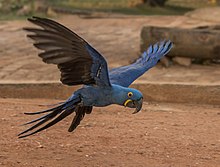
Back مقو بنفسجي Arabic مكاو ياقوتى ARZ Anodorhynchus hyacinthinus AST Anodorhynchus hyacinthinus Azerbaijani Хиацинтов ара Bulgarian Guacamai jacint Catalan Anodorhynchus hyacinthinus CEB Ara hyacintový Czech Macaw dulas Welsh Hyacintara Danish
| Hyacinth macaw | |
|---|---|

| |
| Eating a nut in the Pantanal, Brazil | |

| |
| in flight in the Pantanal | |
| Scientific classification | |
| Domain: | Eukaryota |
| Kingdom: | Animalia |
| Phylum: | Chordata |
| Class: | Aves |
| Order: | Psittaciformes |
| Family: | Psittacidae |
| Genus: | Anodorhynchus |
| Species: | A. hyacinthinus
|
| Binomial name | |
| Anodorhynchus hyacinthinus (Latham, 1790)
| |

| |
The hyacinth macaw (Anodorhynchus hyacinthinus), or hyacinthine macaw, is a parrot native to central and eastern South America. With a length (from the top of its head to the tip of its long pointed tail) of about one meter it is longer than any other species of parrot. It is the largest macaw and the largest flying parrot species; the flightless kākāpō of New Zealand outweighs it at up to 3.5 kg. While generally easily recognized, it could be confused with the smaller Lear's macaw. Habitat loss and the trapping of wild birds for the pet trade have taken a heavy toll on their population in the wild, so the species is classified as Vulnerable on the International Union for Conservation of Nature's Red List,[1] and it is protected by its listing on Appendix I of the Convention on International Trade in Endangered Species of Wild Fauna and Flora (CITES).
- ^ a b BirdLife International (2016). "Anodorhynchus hyacinthinus". IUCN Red List of Threatened Species. 2016: e.T22685516A93077457. doi:10.2305/IUCN.UK.2016-3.RLTS.T22685516A93077457.en.
- ^ "Appendices | CITES". cites.org. Retrieved 14 January 2022.
